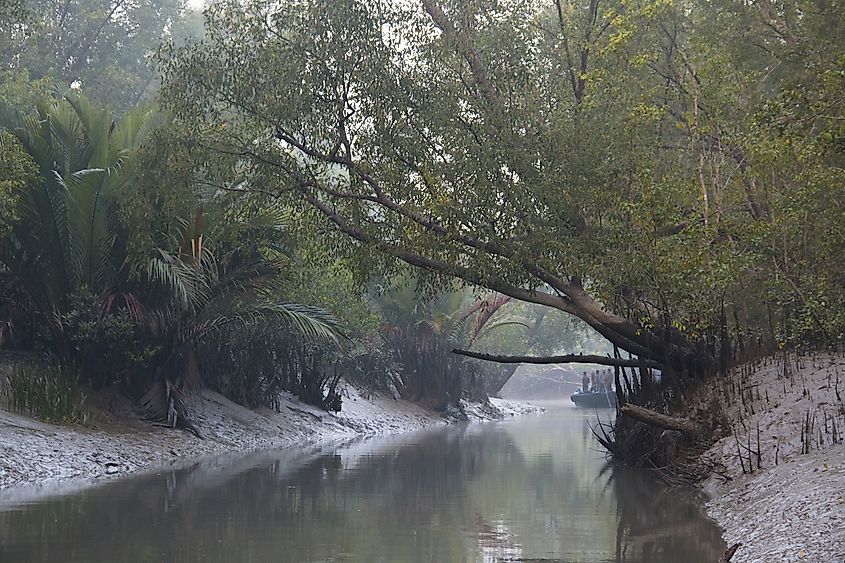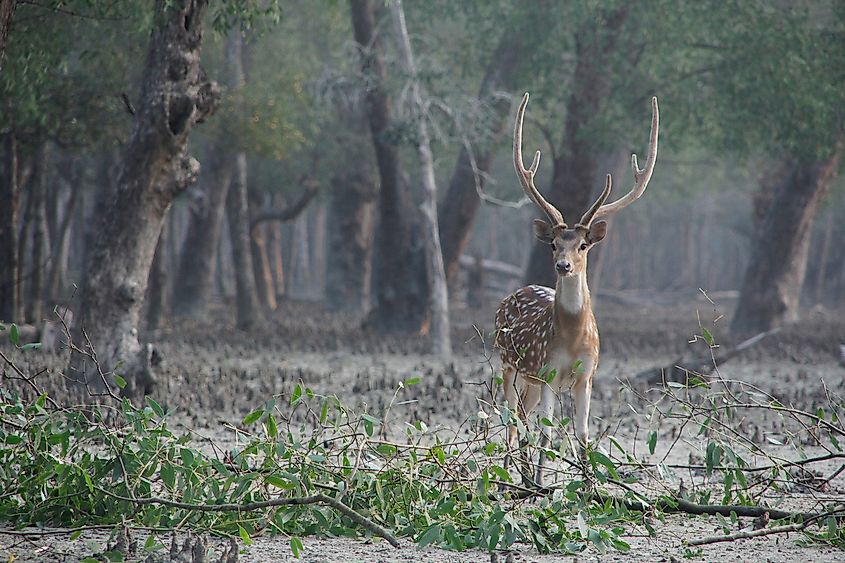Meet The Man Who Spent Time With The Mysterious Mangrove Tigers

"I spent the whole night in the hide and I could hear them feeding, I could hear the bones cracking...so I knew the Tigers were around"
- Mike Herd, Swamp Tigers
Over the years, few outsiders have dared venture into the beautiful yet terrifying terrain of the famous Swamp tigers. This Bengal tiger population inhabits the mysterious mangrove forests of the Sundarbans on the delta along the Bay of Bengal in India and Bangladesh. Throughout history, these tigers have inspired the awe. They have been revered for their enigmatic nature and ability to inhabit a land where everyday life is a constant struggle. These tigers have also earned a reputation as "man-eaters" but that remains a debatable issue.
The world's only tiger population to inhabit the mangroves, the lives of the Sundarbans tigers are shrouded in secrecy. Even today, a lot remains undiscovered about them. The harsh nature of their unique habitat hinders most from studying these tigers in detail. But one man, an award-winning wildlife cameraman, Mike Herd, was not to be stopped. His first glimpse of a stunning male Sundarbans tiger along the bank of a river enticed him enough to dedicate nearly half a year to filming these tigers. Without paying any heed to warnings about the alleged "man-eaters," he decided to enter the home turf of these tigers in the year 2000 in the Sundarbans forests of Bangladesh. His dedication, fearlessness, patience, and talent led to the production of the multi-award winning "Swamp Tigers" documentary. To this day, "Swamp Tigers" continues to thrill viewers by bringing them face to face with the legendary Sundarbans tigers!
World Atlas had the privilege of speaking with Mike Herd, the first person in the world to film the elusive Sundarbans tigers. Learn about his exciting adventures in the land of the world's most mysterious tiger as revealed in the conversation below:

What motivated you to film for the "Swamp Tigers?"
In 1997, I was sent out to Bangladesh to film for a documentary called "In Search of Maneaters." My brief was to get anything at all on the Sundarbans tigers. Knowing that it was almost next to impossible to even catch a glimpse of them in the wilds, there was very little pressure on me. I devised a technique that was successful and managed to get the first controlled footage of the majestic predator in the mangrove forest. I filmed as a large male tiger emerged out of the dense forest and walked along the river bank. Very cautiously, he picked his way through the aerial roots or pneumatophores of the mangrove trees jutting out like sharp spikes from the ground. I was near the end of my trip and about to return to London when this happened. The sight of the tiger made me believe that given enough time and resources, an entire film could be made on these magnificent big cats. That eventually led to "Swamp Tigers".
The Sundarbans is reportedly one of the toughest filming locations in the world. Were you warned of the challenges before taking up the project?
I was well aware that the Bengal tigers of the Sundarbans had never been filmed before with only brief glimpses of them swimming across channels from tourist boats being sighted. Therefore, I knew that my task would be anything but easy. Like most others, I had also heard stories about the many people killed by the Sundarbans tigers, how honey collectors wore masks facing backward to stop tigers approaching them from behind, and so on. But all that hardly registered with me. As far as I was concerned, the slate was clean, and that’s how I started off. I love challenges and I was ready to take the biggest one of my life!

How did you plan to film the tigers in their home turf?
Until the time I embarked on this project, the standard way to film tigers was to build a fifteen-foot machan (a platform on stilts), which I immediately dismissed as unworkable. Who wants to look down on tigers all the time? I vowed that the viewer would feel as vulnerable as me while watching the film. Hence, I embedded the machan into a creek so that the platform for my hide would be about a foot higher than the high tide. That allowed me to look into the forest almost at the same level as the ground without any danger. Of course, there were stories of fishermen being pulled out of their boats so I came armed with a harmless starting pistol and some marine flares. I pledged that no tigers would be harmed regardless of the circumstances. I called these toys my psychological crutches.
Were there any tense moments while you were filming from your machan? Did you not feel threatened being so close to these tigers?
On one occasion I pitched the machan quite close to a bank. Between the hide and the bank was a large tree slightly off to the left. Sitting there, trying to keep alert in the hot still air, I was aware of something nearby. I looked out on my camera angle of vision but that area was empty. I didn’t know why I felt like that. Just to make sure, I gently lifted the netting to my left covering a small window. I saw a striped tail and the back legs of a tiger behind the tree no more than six feet away. I froze. It was perfectly feasible for it to jump straight on to the platform although my hide occupied most of the space. The tail was swishing. Judging by the posture, I guessed that it was trying to work out where I was. I very slowing picked up the gun and held it ready. Eventually, however, I felt the tension go and with it the tiger, melting back into the forest. None of these situations, however, unnerved me. With familiarity, I felt at ease and secure and decided to build a camouflaged cage on the forest floor, something that had never been done nor will ever be done again. That was exciting.

You have observed the Sundarbans tigers up close and personal including tigresses with their cubs. Do you think they are especially aggressive and would attack humans without provocation?
From what I learned by observing them is that they have very simple priorities in life like tigers elsewhere. Hunting prey for food, mating, and raising their young. One day I was happily watching three large cubs playing with their mum when to my left I could hear human voices. She immediately stood up to face the distant intruders while the cubs scampered off in the opposite direction. She stood holding her ground for about a minute and then slowly, turned and followed her young ones. She was in charge and the men never even knew she was there. I worked out that scenes like that must have been very common in the forest. From my experience I would say that as a species, all tigers just want to get on with their lives and try to keep away from people.
Tell us something about your upcoming book.
I have just completed a draft autobiography called "Life in the Wild" that is ready to be pitched to a publisher. Here, I described how my life started as a trainee press photographer leading to filming news and eventually becoming a wildlife cameraman. It includes my many adventures in Africa, Russia, Japan, America, and many other countries. The opening chapter describes me quietly approaching the hide on the forest floor at night and the book ends with the detailed story of how I filmed tigers in the Bangladeshi Sundarbans.











